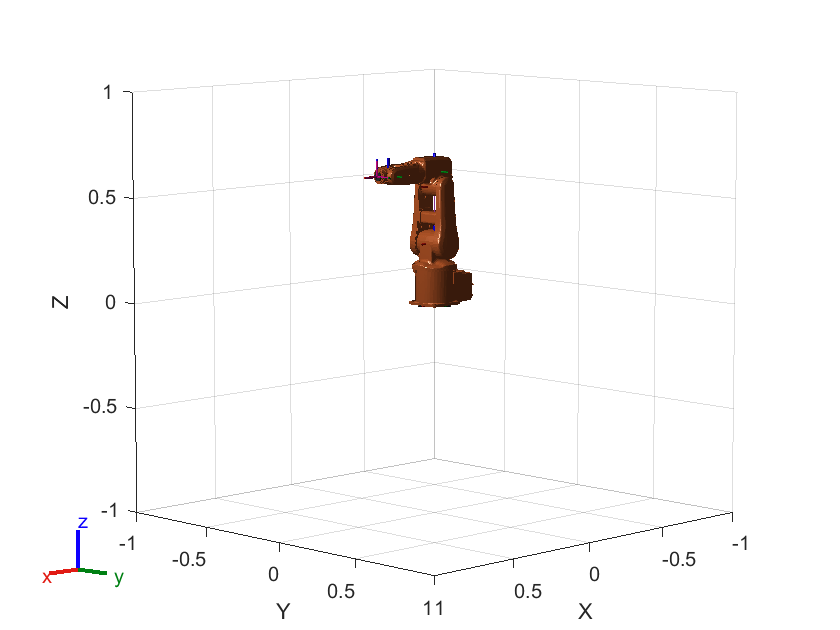urdfExporter
Description
Use urdfExporter object to generate a unified robot description
format (URDF) file from the rigidBodyTree object. You can modify the
details in the generated URDF file with supported functionalities.
Creation
Description
exporter = urdfExporter(robot)urdfExporter object for the rigidBodyTree robot model robot.
Properties
Name of the generated URDF file, specified as a string scalar or character vector. You can specify this property as a filename or a pathname.
Data Types: char | string
Robot name attribute corresponding to the robot name tag in the
generated URDF file, specified as a string scalar or character vector. It returns as a
valid robot model name such as "abbIrb120",
"abbIrb120T", "abbIrb1600".
Data Types: char | string
Visual mesh files location corresponding to the filename
attribute under the mesh tag of the visual tag in
the generated URDF file, specified as a string scalar or character vector.
The default location corresponds to the path you specify in the rigidBodyTree object. You can also modify the visual mesh path from
generated URDF file to a location of your preference.
Example: "C:/URDF/abb_irb120_support/meshes/"
Data Types: char | string
Collision mesh files location corresponding to the filename
attribute under the mesh tag of the collision tag
in the generated URDF file, specified as a string scalar or character vector.
The default location corresponds to the path you specify in the rigidBodyTree object. You can also modify the collision mesh path from
generated URDF file to a location of your preference.
Example: "C:/URDF/abb_irb120_support/meshes/"
Data Types: char | string
Option to enable mesh file export, specified as a numeric or logical value of
0 (false) or 1 (true). The generated ZIP package
contains the output URDF files and mesh files.
Data Types: logical | numeric
Maximum permissible difference in the values under tags in exported URDF, specified
as a positive scalar. The default value is sqrt(eps), where
eps returns the distance from 1.0 to the next
largest double-precision number, which is equal to
2-52. For more information, see
eps.
Data Types: single | double
Object Functions
Examples
This example shows how to load a robot as a rigidBodyTree model and export the robot details as a URDF file.
Load a rigidBodyTree robot model. The rigidBodyTree object contains kinematic and dynamic constraints and visual meshes for the specified robot geometry.
robotRBT = loadrobot("abbIrb120");Create a rigidBody object with a unique name.
body1 = rigidBody("link1");By default, the rigidBody object comes with a fixed joint. Replace the joint by assigning a new rigidBodyJoint object to the body1.Joint property.
body1.Joint = rigidBodyJoint(jnt1="revolute");Add the rigidBody object to the rigidBodyTree robot model. Specify the body name to which you are attaching the rigid body. Use the base name of the tree for the first body.
basename = robotRBT.BaseName; addBody(robotRBT,body1,basename);
Confirm that the rigid body and joint are correct by using showdetails.
showdetails(robotRBT)
-------------------- Robot: (9 bodies) Idx Body Name Joint Name Joint Type Parent Name(Idx) Children Name(s) --- --------- ---------- ---------- ---------------- ---------------- 1 base base_link-base fixed base_link(0) 2 link_1 joint_1 revolute base_link(0) link_2(3) 3 link_2 joint_2 revolute link_1(2) link_3(4) 4 link_3 joint_3 revolute link_2(3) link_4(5) 5 link_4 joint_4 revolute link_3(4) link_5(6) 6 link_5 joint_5 revolute link_4(5) link_6(7) 7 link_6 joint_6 revolute link_5(6) tool0(8) 8 tool0 joint6-tool0 fixed link_6(7) 9 link1 jnt1 revolute base_link(0) --------------------
Visualize the robot model.
show(robotRBT)

ans =
Axes (Primary) with properties:
XLim: [-1 1]
YLim: [-1 1]
XScale: 'linear'
YScale: 'linear'
GridLineStyle: '-'
Position: [0.1300 0.1100 0.7750 0.8150]
Units: 'normalized'
Show all properties
Add visuals to the robot model.
body9 = robotRBT.Bodies{9};
addVisual(body9,box=[0.1 0.1 0.1]);Visualize the robot model with the added visuals.
show(robotRBT)

ans =
Axes (Primary) with properties:
XLim: [-1 1]
YLim: [-1 1]
XScale: 'linear'
YScale: 'linear'
GridLineStyle: '-'
Position: [0.1300 0.1100 0.7750 0.8150]
Units: 'normalized'
Show all properties
Create a URDF exporter object. Package the mesh and URDF details in one folder.
exporter = urdfExporter(robotRBT); exporter.ExportMesh = true;
Write the packaged mesh and URDF details into the specified file.
writefile(exporter,OutputfileName="abbIrb120.urdf")This example shows how to load a robot as rigidBodyTree model and generate XML DOM node from it. You also modify the robot details in the XML DOM node and write the modified details in the URDF file.
Load a rigidBodyTree robot model. The rigidBodyTree contains kinematic and dynamic constraints and visual meshes for the specified robot geometry.
robotRBT = importrobot("iiwa7.urdf");Create a URDF exporter object.
exporter = urdfExporter(robotRBT);
Get robot details in the XML DOM node.
node = exporter.writenode();
Get specific joint element from the robot element.
jn0 = node.getElementsByTagName(... "robot").item(0).getElementsByTagName(... "joint").item(0);
Modify the joint type to "fixed" of the specified joint element.
jn0.setAttribute("type","fixed");
Write the modified details in URDF file format.
writer = matlab.io.xml.dom.DOMWriter;
writeToFile(writer,node,"iiwa7.urdf")Version History
Introduced in R2023b
MATLAB Command
You clicked a link that corresponds to this MATLAB command:
Run the command by entering it in the MATLAB Command Window. Web browsers do not support MATLAB commands.
Select a Web Site
Choose a web site to get translated content where available and see local events and offers. Based on your location, we recommend that you select: .
You can also select a web site from the following list
How to Get Best Site Performance
Select the China site (in Chinese or English) for best site performance. Other MathWorks country sites are not optimized for visits from your location.
Americas
- América Latina (Español)
- Canada (English)
- United States (English)
Europe
- Belgium (English)
- Denmark (English)
- Deutschland (Deutsch)
- España (Español)
- Finland (English)
- France (Français)
- Ireland (English)
- Italia (Italiano)
- Luxembourg (English)
- Netherlands (English)
- Norway (English)
- Österreich (Deutsch)
- Portugal (English)
- Sweden (English)
- Switzerland
- United Kingdom (English)